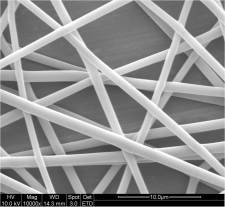▼ Reference
- Akkurt S, Renye J, Tomasula PM. Encapsulation of Lactobacillus rhamnosus GG in edible electrospun mats from calcium and sodium caseinates with pullulan blends. JDS Communications 2022; 3: 381. Open Access
- Cardenas W, Gomez-Pachon E Y, Munoz E, Vera-Graziano R. Preparation of potato starch microfibers obtained by electro wet spinning. IOP Conf. Series: Materials Science and Engineering 2016; 138: 012001. Open Access
- Heuvel M, Geerdink P, Brier P, Eijnden P, Henket J T M M, Langelaan M L P, Stroeks N, Deventer H C, Martin A H. Food-grade electrospinning of proteins. InsideFood Symposium 2013, 9-12 April, Leuven, Belgium.
- Jiang Q, Reddy N, Yang Y. Cytocompatible cross-linking of electrospun zein fibers for the development of water-stable tissue engineering scaffolds. Acta Biomater. 2010; 6: 4042.
- Lepe P G T, Tucker N, Simmons L, Watson A J A, Fairbanks A J, Staiger M P. Sub-micron sized saccharide fibres via electrospinning. Electrospinning 2015; 1: 1. Open Access
- Liu S C, Li R, Tomasula P M, Sousa A M M, Liu L. Electrospun Food-Grade Ultrafine Fibers from Pectin and Pullulan Blends. Food and Nutrition Sciences 2016; 7: 636. Open Access
- Lubambo AF, de Freitas RA, Sierakowski MR, Lucyszyn N, Sassaki GL, Serafim BM, et al. Electrospinning of commercial guar-gum: Effects of purification and filtration. Carbohydrate Polymers. 2013; 93(2): 484-491. doi: 10.1016/j.carbpol.2013.01.031
- Luo C J, Loh S, Stride E, Edirishinghe M. Electrospraying and Electrospinning of Chocolate Suspensions. Food and Bioprocess Technology 2012; 5: 2285.
- Shahbazi E, Kiumars Bahrami K. Production and Properties Analysis of Honey Nanofibers Enriched with Antibacterial Herbal Extracts for Repair and Regeneration of Skin and Bone Tissues. Journal of Pharmacy and Pharmacology 2019; 7: 37. Open Access
- Shankar A, Setam A F M, Hudson S M. Electrospinning of Soy Protein Fibers and their Compatibility with Synthetic Polymers. Journal of Textile and Apparel, Technology and Management 2013; 8: 1. Open Access
- Sullivan S T, Tang C, Kennedy A, Talwar S, Khan S A. Electrospinning and heat treatment of whey protein nanofibers. Food Hydrocolloids 2014; 35: 36.
- Sutjarittangtham K, Jaiturong P, Intatha U, Pengpat K, Eitssayeam S, Sirithunyalug J. Fabrication of Natural Tapioca Starch Fibers by a Modified Electrospinning Technique. Chiang Mai J. Sci. 2014; 41: 213. Open Access
- Suwantong O, Pavasant P, Supaphol P. Electrospun Zein Fibrous Membranes Using Glyoxal as Cross-Linking Agent: Preparation, Characterization and Potential for Use in Biomedical Applications. Chiang Mai J. Sci. 2011; 38: 56. Open Access
- Yang W, Sousa AMM, Li X, Tomasula PM, Liu L. Electrospinning of Guar Gum/Corn Starch Blends. SOJ Mater Sci Eng 2017; 4(1): 1-7. Open Access
▼ Credit and Acknowledgement
Author
Wee-Eong TEO View profile
Email: weeeong@yahoo.com
 ElectrospinTech
ElectrospinTech

